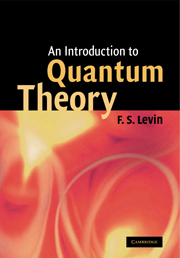Book contents
- Frontmatter
- Contents
- Preface
- PART I INTRODUCTORY
- Chapter 1 The Need for a Non-Classical Description of Microscopic Phenomena
- Chapter 2 Classical Concepts and Quantal Inequivalences
- Chapter 3 Introducing Quantum Mechanics: A Comparison of the Classical Stretched String and the Quantal Box
- Chapter 4 Mathematical Background
- PART II THE CENTRAL CONCEPTS
- PART III SYSTEMS WITH FEW DEGREES OF FREEDOM
- PART IV COMPLEX SYSTEMS
- Appendix A Elements of Probability Theory
- Appendix B Fourier Series and Integrals
- Appendix C Solution of Legendre's Equation
- Appendix D Fundamental and Derived Quantities: Conversion Factors
- References
- Index
Chapter 4 - Mathematical Background
Published online by Cambridge University Press: 05 June 2012
- Frontmatter
- Contents
- Preface
- PART I INTRODUCTORY
- Chapter 1 The Need for a Non-Classical Description of Microscopic Phenomena
- Chapter 2 Classical Concepts and Quantal Inequivalences
- Chapter 3 Introducing Quantum Mechanics: A Comparison of the Classical Stretched String and the Quantal Box
- Chapter 4 Mathematical Background
- PART II THE CENTRAL CONCEPTS
- PART III SYSTEMS WITH FEW DEGREES OF FREEDOM
- PART IV COMPLEX SYSTEMS
- Appendix A Elements of Probability Theory
- Appendix B Fourier Series and Integrals
- Appendix C Solution of Legendre's Equation
- Appendix D Fundamental and Derived Quantities: Conversion Factors
- References
- Index
Summary
The quantities in physics that can be measured are conventionally denoted observables: entities that can be observed (directly or indirectly) and to which a value in appropriate units can be assigned. Examples include position, momentum, and energy. Unlike in classical physics, the concept of an observable in quantum theory possesses a significance beyond that of the measurable: to each observable there corresponds a unique operator in an abstract, linear vector space. These operators (and others) govern all aspects of quantum systems.
Quantum operators act on abstract vectors in the linear space. Especially important are the eigenvectors and eigenvalues of these operators, in particular because some of the eigenvectors are the quantum states mentioned in the preceding chapters. Furthermore, for any operator that is the mathematical image of an observable, its eigenvalues constitute the entire set of values that measurement of the observable can yield. Finally, from the quantum states one can obtain the probabilities for the occurrence of events in the microscopic world, for example, the most likely value that measurement of an observable will yield.
The concepts of operators and eigenvalue problems, as well as those of quantal probabilities, of Hermiticity, and of complete sets, were encountered and exemplified in the preceding chapter using the language of differential equations. While much of quantum mechanics could be presented in terms of this language alone, certain fundamental concepts (spin, for instance) cannot be, and it eventually becomes necessary to consider quantum mechanics as a theoretical framework embedded in that abstract linear vector space known as a Hilbert space.
- Type
- Chapter
- Information
- An Introduction to Quantum Theory , pp. 84 - 126Publisher: Cambridge University PressPrint publication year: 2001



